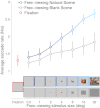An oculomotor continuum from exploration to fixation
- PMID: 23533278
- PMCID: PMC3625326
- DOI: 10.1073/pnas.1222715110
An oculomotor continuum from exploration to fixation
Abstract
During visual exploration, saccadic eye movements scan the scene for objects of interest. During attempted fixation, the eyes are relatively still but often produce microsaccades. Saccadic rates during exploration are higher than those of microsaccades during fixation, reinforcing the classic view that exploration and fixation are two distinct oculomotor behaviors. An alternative model is that fixation and exploration are not dichotomous, but are instead two extremes of a functional continuum. Here, we measured the eye movements of human observers as they either fixed their gaze on a small spot or scanned natural scenes of varying sizes. As scene size diminished, so did saccade rates, until they were continuous with microsaccadic rates during fixation. Other saccadic properties varied as function of image size as well, forming a continuum with microsaccadic parameters during fixation. This saccadic continuum extended to nonrestrictive, ecological viewing conditions that allowed all types of saccades and fixation positions. Eye movement simulations moreover showed that a single model of oculomotor behavior can explain the saccadic continuum from exploration to fixation, for images of all sizes. These findings challenge the view that exploration and fixation are dichotomous, suggesting instead that visual fixation is functionally equivalent to visual exploration on a spatially focused scale.
Conflict of interest statement
The authors declare no conflict of interest.
Figures





References
-
- Yarbus AL. Movements of the Eyes. New York: Plenum; 1967.
-
- Dodge R. An experimental study of visual fixation. The Psychological Review: Monograph Supplements. 1907;8(4):i–95.
-
- Ratliff F, Riggs LA. Involuntary motions of the eye during monocular fixation. J Exp Psychol. 1950;40(6):687–701. - PubMed
-
- Rolfs M. Microsaccades: Small steps on a long way. Vision Res. 2009;49(20):2415–2441. - PubMed
Publication types
MeSH terms
LinkOut - more resources
Full Text Sources
Other Literature Sources
Research Materials

